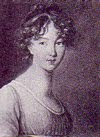

I have been re-working this pattern for Knitted Mitten and Bracelet, Godey’s Lady’s Book and Magazine, Volume 51, August, 1855, pp. 169-170 which can be found at
http://books.google.com/books?id=K8ZMAAAAMAAJ&pg=PA10...=onepage&q=godey’s%20august%201855&f=false
I used the same wools as before (vintage Beehive Moorland and Morehouse Farm Merino Lace) on 2mm/0US dpns for the cuff and bracelet, and 2.25mm/1US for the hand.
The pattern suggests a “bracelet” for the wrist but does not include instructions for one. I looked at and tried out several patterns for ruffles and frills (which is what the Bracelet really is) from periodical patterns of the 1850’s-1880’s and found one that comes close in words to a ruffle in the “frill” pattern for a Legging for a Lady or Child by Mrs. Jane Weaver, Peterson’s Magazine, Volume 50, No. 3, September, 1866, pp. 205-206. The frill pattern is on page 206 but it does not resemble the illustration of the one on the Legging:
http://books.google.com/books?id=4iHQAAAAMAAJ&pg=PA20...=onepage&q=knitted%20frill&f=false
It also does not resemble the bracelet in spite of its similarity to the six row pattern for the ruffle of the 1880’s Night-Cap in Double Rose-Leaf Pattern, published in Weldon’s Practical Knitter, Twenty-Sixth Series: (http://historyknits.blogspot.com/2008_07_01_archive.html Scroll down to July 15th, 2008.)
The nine row Peterson’s pattern, due to the combination of knit and purl stitches in each set, produces a rather flat edging. I first knit this frill on 4.50mm/7US needles in Nature Spun Worsted (so I could really see the stitches, and then on 1.75mm/00US in Nature Spun Lace Weight, and it came out completely flat in the heavier yarn. The white Morehouse Farm Merino Lace on 2.25mm/1US needles sample was more delicate but needed encouragement to stand up or buckle. It still did not really resemble the tight, rippling Bracelet of the 1855 mitt pattern which is interesting as the increase method resembles the Weldon’s frill/ruffle pattern except for the combination of knit and purl stitches in each set (which provides the flattening effect), the added number (usually two) of non-increase stitches in each set of increases (there are more in the Peterson’s) and the repeat rows of non-increase rows.
The grey Morehouse Farm Merino Lace sample is the Peterson’s pattern with only one non-increase row in between the increase rows. There is less flatness but still not as much ripple as in the Weldon’s pattern.
In conclusion, the Weldon’s ruffle pattern (on the brown mitt here) from the 1880’s most closely resembles the illustration of the Bracelet of 1855 which leads me to believe that the Weldon’s pattern is a basic ruffle pattern that was in use for quite a few decades throughout the 19th century since the 1855 pattern’s writer assumed it was a technique that was generally known and there was, therefore, no need to include it with the pattern for the mitts. The search continues, however, to find it in print in a publication from an earlier part of the 19th century.













































